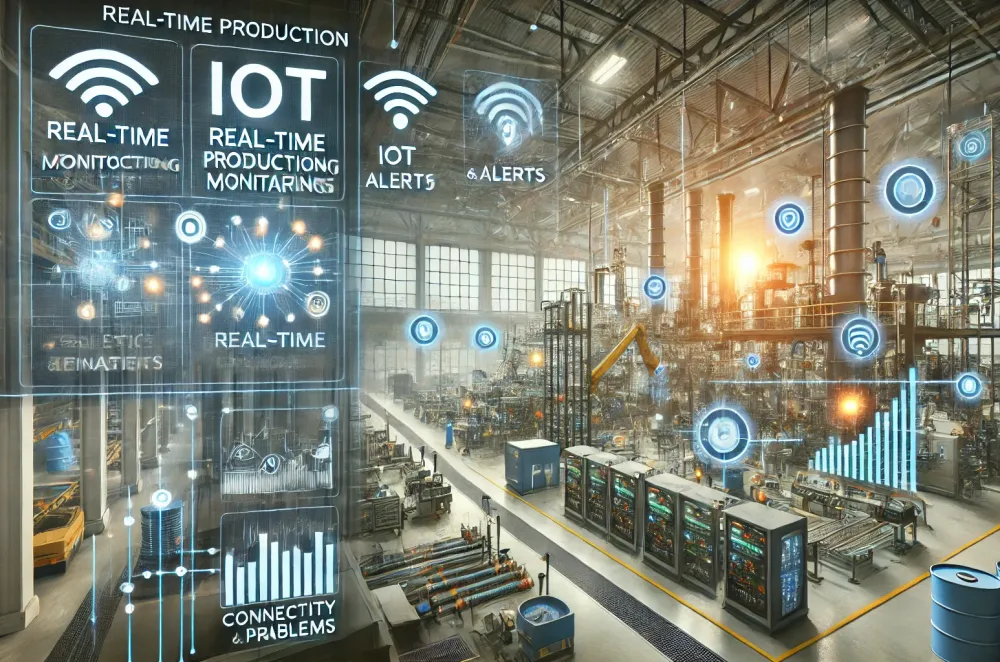Integrating Real-Time Production Monitoring with IoT: Opportunities and Challenges
The integration of Internet of Things (IoT) technology with real-time production monitoring systems holds significant potential for transforming manufacturing operations. This post explores the opportunities this integration offers, the challenges it presents, and strategies to overcome these obstacles.
Opportunities of Integrating IoT with Real-Time Production Monitoring
Enhanced Operational Efficiency
IoT technology enables the collection and analysis of vast amounts of data from various production processes in real-time. This leads to several efficiency improvements:
- Real-Time Data Insights: IoT sensors provide continuous data streams, allowing for real-time monitoring and decision-making. This enables quick responses to production issues, reducing downtime and increasing productivity.
- Automation: IoT devices can automate routine tasks and processes, freeing up human resources for more complex activities and reducing the risk of human error.
- Predictive Maintenance: IoT analytics can predict equipment failures before they occur, enabling proactive maintenance schedules that minimize unplanned downtime and extend equipment life.
Improved Quality Control
Integrating IoT with production monitoring enhances quality control by providing precise and real-time data:
- Continuous Monitoring: IoT sensors track product quality at every stage of production, ensuring that defects are identified and addressed immediately.
- Data-Driven Quality Assurance: Historical and real-time data analysis helps identify trends and anomalies, allowing for continuous improvement in quality standards.
Supply Chain Optimization
IoT integration extends beyond the production floor, impacting the entire supply chain:
- Inventory Management: Real-time tracking of inventory levels ensures optimal stock levels, reducing waste and avoiding stockouts.
- Supplier Coordination: IoT provides real-time updates on supplier deliveries and performance, enabling better coordination and efficiency in the supply chain.
Challenges of IoT Integration in Production Monitoring
Data Security and Privacy
One of the significant challenges of integrating IoT in production monitoring is ensuring data security and privacy:
- Vulnerability to Cyber Attacks: IoT devices can be targets for cyberattacks, potentially compromising sensitive production data and disrupting operations.
- Data Privacy Regulations: Compliance with data privacy laws and regulations requires robust security measures and protocols.
Interoperability and Integration
Integrating IoT with existing production monitoring systems can be complex:
- Compatibility Issues: Ensuring that IoT devices and sensors are compatible with existing systems and software is essential for seamless integration.
- Data Integration: Aggregating data from various IoT devices into a cohesive and usable format can be challenging, requiring sophisticated data management solutions.
Cost and Infrastructure
The initial investment and infrastructure requirements for IoT integration can be substantial:
- Upfront Costs: The cost of IoT devices, sensors, and the necessary infrastructure can be high, particularly for small and medium-sized enterprises.
- Ongoing Maintenance: Maintaining and upgrading IoT systems requires continuous investment in technology and skilled personnel.
Strategies to Overcome Integration Challenges
Implement Robust Security Measures
To address data security and privacy concerns:
- Encryption: Use strong encryption protocols to protect data transmitted between IoT devices and monitoring systems.
- Access Controls: Implement strict access controls and authentication mechanisms to limit access to sensitive data.
- Regular Audits: Conduct regular security audits and vulnerability assessments to identify and mitigate potential risks.
Ensure Compatibility and Standardization
For seamless interoperability and integration:
- Standardized Protocols: Use standardized communication protocols and interfaces to ensure compatibility between IoT devices and existing systems.
- Scalable Solutions: Choose IoT solutions that are scalable and flexible to accommodate future growth and technological advancements.
Manage Costs Effectively
To mitigate the financial impact:
- Phased Implementation: Implement IoT integration in phases, starting with critical areas and gradually expanding as resources allow.
- ROI Analysis: Conduct a thorough return on investment (ROI) analysis to justify the costs and highlight the long-term benefits of IoT integration.
Conclusion
Integrating IoT technology with real-time production monitoring offers numerous opportunities for enhancing operational efficiencies, improving quality control, and optimizing the supply chain. However, it also presents challenges such as data security, interoperability, and cost. By implementing robust security measures, ensuring compatibility, and managing costs effectively, manufacturers can successfully navigate these challenges and harness the full potential of IoT in their production processes.
Embrace the future of manufacturing with IoT-integrated real-time production monitoring and unlock unprecedented levels of efficiency and innovation in your operations.
Interested in digital transformation? Let's discuss!
